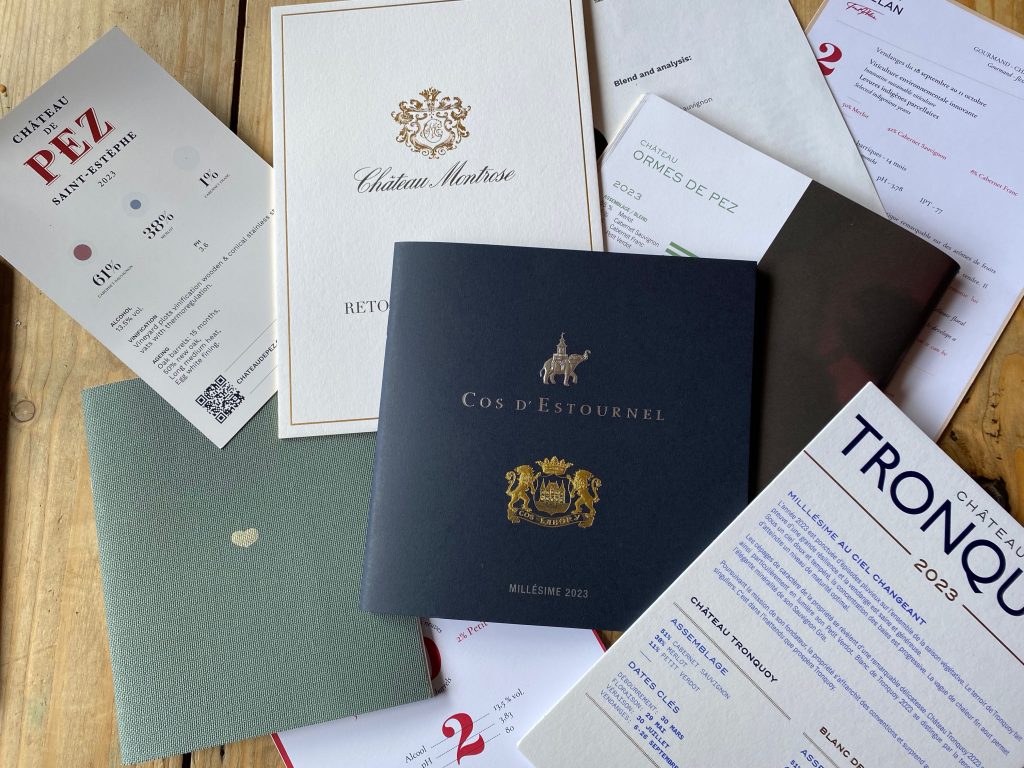St Estèphe 2023 en primeur: a subtle but significant change in the blend
For a long time unfavourably dismissed as the cool, damp and somewhat austere ugly sister of the great appellations to the south, St-Estèphe has a newfound optimism, with 2023 perfectly suiting the late-ripening Cabernet Sauvignon. db‘s Bordeaux correspondent Colin Hay reports.

Leaving Pauillac behind as we continue our northward passage through the Médoc we come almost immediately to St-Estèphe. This was, for long, rather unfavourably dismissed as the cool, damp and somewhat austere ugly sister of the great appellations to the south.
Not any more. For although it is not exactly the poster child of global warming, if there is a single Médoc appellation to have benefitted most from climate change to date then it is undoubtedly St-Estèphe.
In keeping with such new-found optimism, 2023 was good up here. The average temperature throughout the growing season, and notably from véraison to harvest, was a little above the (rising) ten-year average. And, as Table 1 makes clear, although total rainfall was a little above the same (now falling) ten-year average, it was rather more evenly distributed across the growing season. Significantly, there was rather less intense mildew pressure in June than in any other leading appellation of the region.
|
Pre-budburst (Nov-March) |
Budburst to Harvest (April-mid October) |
Total (1/11-15/10) |
|
| St-Estèphe | 550.7 (+3.0%) | 411.8 (+4.7%) | 912.5 (+1.5%) |
| Pauillac | 458 (-5.8%) | 441.3 (+13.2%) | 899.2 (+1.2%) |
| Margaux | 398 (-19.3%) | 464.6 (+11.0%) | 862.6 (-5.7%) |
| St-Julien | 458 (-5.8%) | 441.3 (+13.2%) | 899.2 (+1.2%) |
| Pessac-Léognan | 426 (-12.4%) | 469.4 (+14.5%) | 895.2 (0%) |
| St-Emilion | 306 (-37.1%) | 490.8 (+18.1%) | 796.8 (-11.8%) |
| Pomerol | 338 (-31.5%) | 470.0 (+14.5%) | 808.1 (-10.9%) |
Table 1: Rainfall during the vintage (relative to 10-year average)
Source: calculated from Saturnalia’s Bordeaux 2023 Harvest report.
The result, as Table 2 shows clearly, is that average vineyard yields in the appellation rose by a full 20 hl/ha from a paltry 31.5 hl/ha in the hail-ravaged 2022 vintage to an almost record-shattering and certainly chart-topping 51.6 hl/ha in 20223.
Yet crucial to this was not just the lower early summer rainfall totals which meant that St-Estèphe endured rather less of the mildew pressure experienced further south. No less significant was the capacity of St-Estèphe’s cooler, more clay-dominated, soils to absorb and buttress the intense heatwave episodes of the second half of August and early September.
Whilst the grapes were desiccating and burning on the vines in the Indian Summer conditions further south they were slowly and surely reaching perfect maturity further north. The ugly sister was blossoming in the late summer sunshine.
| 2019 | 2020 | 2021 | 2022 | 2023 | 10-year average | Relative to 10-year average (% change) | |
| St Estèphe | 49.7 | 41.2 | 40.7 | 31.5 | 51.6 | 43.4 | +18.9 |
| St Julien | 45.5 | 34.3 | 35.2 | 34.3 | 50.3 | 40.1 | +25.4 |
| Margaux | 49.2 | 36.3 | 38.6 | 31.3 | 37.7 | 39.7 | -5.0 |
| Pauillac | 46.7 | 37.4 | 35.1 | 34.8 | 47.1 | 39.7 | +18.6 |
| Pessac-Léognan rouge | 47.2 | 34.6 | 30.7 | 35.7 | 38.1 | 38.5 | -1.0 |
| St Emilion (GC) | 43.0 | 36.7 | 27.5 | 41.2 | 40.5 | 37.2 | +8.9 |
| Pomerol | 43.0 | 39.8 | 28.9 | 32.3 | 45.2 | 36.1 | +25.2 |
Table 2: Average vineyard yield by appellation (hl/ha)
Partner Content
Source: calculated from Duanes data compiled by the CIVB Service Economie et Etudes.
This was, above all, crucial for the late-ripening Cabernet Sauvignon. It is perhaps unsurprising then that 2023 sees a subtle but significant change in the final blends of the appellation’s grands vins.
Indeed, as Table 3 shows, although Cabernet Sauvignon did not quite attain the dominance in the blend it achieved in 2021 (when a lot of Merlot struggled to attain full ripeness), it typically represents two-thirds of the blend in the leading wines of the appellation, with Merlot relegated to a relatively paltry 22 per cent.
| Wine | % Merlot | % Cabernet Sauvignon | ||||||
| 2020 | 2021 | 2022 | 2023 | 2020 | 2021 | 2022 | 2023 | |
| Calon Ségur | 12 | 7 | 24 | 15 | 78 | 81 | 70 | 72 |
| Cos d’Estournel | 38 | 30 | 37 | 33 | 62 | 64 | 61 | 65 |
| Montrose | 23 | 31 | 25 | 21 | 71 | 62 | 66 | 75 |
| Lafon Rochet | 33 | 26 | 31 | 29 | 61 | 69 | 65 | 64 |
| Phélan-Ségur | 42 | 21 | 56 | 38 | 54 | 75 | 40 | 60 |
| Average | 30 | 23 | 35 | 22 | 65 | 70 | 60 | 67 |
Table 3: Percentage of Merlot & Cabernet Sauvignon in the grand vin, 2020-23
Given all of this is perhaps not surprising that I find St-Estèphe, like the northern part of Pauillac and as in the 2014 vintage (if for rather different reasons), something of a figurative hot spot in 2023. Time and again, its wine have triumphed.
Montrose remains, not for the first time, a class apart – a genuine qualitative peer of the the first growths. It is for me the wine of the appellation once again. Though I was blown away by the quality of the 2019, 2020 and 2022 I have, quite simply, never tasted better from this address.
That seems, in a way, just a little harsh on Cos d’Estournel. Because it, too, has produced a truly exquisite and exceptional wine that in any other great vintage (and plenty of other appellations) would surely merit ‘wine of the appellation’ consideration. That these two greats are on such fantastic form in this vintage is, of course, brilliant for the appellation and for its reputation; but it does seem a little tough on a wine that had me purring in the tasting room once again.
Calon-Ségur, Phélan-Ségur, Meyney and Tronquoy have each produced fabulous wines too. Each deserves a place in a well-stocked cellar and each will give at least two decades of pleasure for those with the patience to wait that long.
But it with de Pez and, perhaps above all, Cos Labory that I must conclude. These perhaps share the prize for the most improved properties in the entire Médoc, though de Pez of course has had a couple of years’ head-start on Cos Labory. Quite simply each has made in 2023 the best wine I have ever tasted from the property – by some distance in the case of the latter. What they both show so well is the difference that top-tier vineyard management and vinification can bring to a wine in a relatively small span of time. The Pichon Comtesse signature at de Pez is clear and has been for a handful of vintages now; the Cos d’Estournel touch at Cos Labory is already transformative. I cannot wait to taste the 2024 and 2025 vintages from these addresses.
Highlights in 2023
Wine of the appellation:
- Montrose (98-100)
Truly great:
- Cos d’Estournel (96-98+)
- Calon-Ségur (94-96)
- De Pez (93-95)
- Cos Labory (92-94+)
- Phélan-Ségur (92-94+)
Value picks:
- De Pez (93-95)
- Dame de Montrose (92-94+)
- Tronquoy (92-94+)
- Le Crock (92-94)
- Haut-Marbuzet (92-94)
- Meyney (92-94)
- Domeyne (91-93)
See here for Colin’s full tasting notes for St Estèphe and his appellation analysis for Margaux, St Julien, Pauillac, St Estèphe and Saint Émilion.
Read more:
A guide to Bordeaux 2023 in ten questions
Bordeaux 2023 vintage report part I: quality and quantity together, for once
Bordeaux vintage report part 2: a vintage of reactivity, vigilance and surveillance
Related news
All the medallists from The Prosecco Masters 2025




